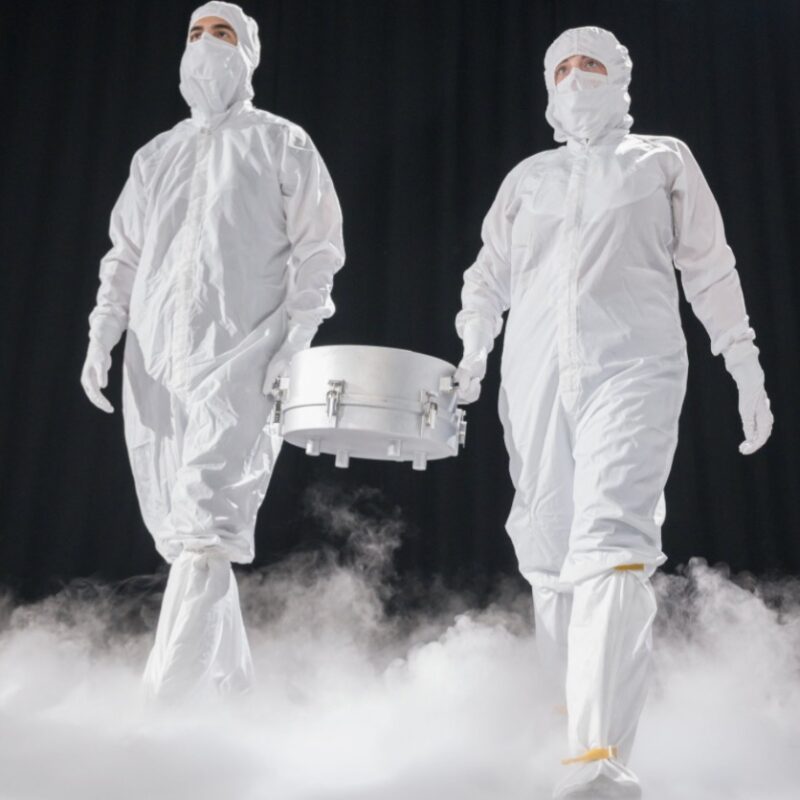
- NASA’s OSIRIS-REx space mission launched from Earth in 2016, collected samples of asteroid Bennu in 2020 and returned the samples to Earth in a dramatic drop from space in September 2023.
- There are now 3 places on Earth where the public can view the samples of Bennu: in Arizona, Texas and Washington, D.C.
- Preliminary analysis of Bennu samples suggest the asteroid is a remnant of a small planet-like body, perhaps an ocean world.
See asteroid Bennu on display
Remember how exciting it was on September 24, 2023, when – after a journey of nearly 3.9 billion miles (6.8 billion km) – the OSIRIS REx spacecraft dropped its return capsule carrying pieces of asteroid Bennu onto a Utah desert? The samples were quickly whisked away to a clean room in Houston for analysis. But now they’re on display at three museums in the U.S. Would you like to see them?
If so, there are three places you can go. The Smithsonian National Museum of Natural History in Washington, D.C., has a sample of Bennu. Space Center Houston in Texas has one. It’s the official visitors’ center of NASA’s Johnson Space Center in Houston. And the University of Arizona’s Alfie Norville Gem & Mineral Museum now has a small sample of Bennu, collected by NASA’s OSIRIS-REx mission and brought back to Earth last September. The University of Arizona led the principal science operations for the mission.
These are the only three places in the world to showcase a piece of an extraterrestrial rock, apart from the moon rocks brought back by the Apollo missions.
A special sample from asteroid Bennu
Meteorites are common. You can find many on display in museums and even buy them. But the Bennu sample is unique in that a robotic spacecraft collected it from the parent asteroid itself. As the director of the Alfie Norville Gem & Mineral Museum, Violetta Wolf, said in a statement on March 6:
What’s so special about the Bennu sample is that it was collected directly at the asteroid, in space, and that’s something that we really try to help our visitors understand.
While meteorites are abundant, this is a rare sample plucked directly from an asteroid and brought back to Earth. Also, heat affects meteorites as they travel through the atmosphere. They’re also exposed to air, water, microbes and other contaminants. The Bennu sample, however, is still pristine. Wolf said:
To have something that actually has never been in contact with our atmosphere or anything else on our planet is exceptional and incredibly rare. We only have two pieces in the museum like that, and that’s the lunar sample and now the sample from Bennu.

A long journey home
It took OSIRIS-REx seven years to bring the sample back from Bennu to Earth. During that time, the spacecraft traveled an incredible 4 billion miles (6 billion km). The spacecraft safely stored the sample of rocky regolith inside an airtight capsule for delivery. Overall, OSIRIS-REx collected a total of 121.6 grams (4.29 ounces) of material. That may not sound like much, but it’s more than enough for scientists to study and analyze.
At the University of Arizona, scientists received 200 milligrams (about seven-thousandths of an ounce) of that material for study. The pebble on display there is a bit larger than Bennu’s sand-sized bits. It’s dark in color, which you can see in photographs of the entire sample from the capsule (such as the one below), with well-defined structure and texture. Wolf added:
It’s not huge, of course, but for a sample of this significance, it’s actually pretty large. You can actually see it’s a small pebble, very dark, almost black. It almost seems like something you would shake out your shoe after a long hike. If you look closely, you can see some different textures in it, some different colors.

A well-protected and valuable piece of asteroid Bennu
The spacecraft protected the sample for its journey to Earth. And now, the small pieces of the asteroid on display remain highly protected. They’re sealed inside clear containers with strong metal casings. Inside the containers is nitrogen. This further protects the samples from contamination by air and chemicals.
Wolf said:
NASA’s approach to scientific research is that it has to also benefit the public through interpretation and getting young people excited about careers in science and space-related research and technology. Putting it in its display case really was a humbling moment, recognizing what just passed through our hands.
As Wolf noted, the Alfie Norville Gem & Mineral Museum will be adding more information about the sample as they learn more from ongoing analysis.
This is not a ‘one and done’ kind of exhibit. We’re going to keep adding more information as we learn. Having this on display is a huge milestone, but there’s still so much to come.
After OSIRIS-REx successfully delivered the sample to Earth last September, there was an unexpected glitch. The lid on the sample container was stuck. Really stuck. It took months of careful work, but the curation team at NASA’s Johnson Space Center in Houston, Texas, finally removed it last January.
Analysis of the sample material from Bennu shows it’s rich in water, clays, carbon, nitrogen, sulfur, phosphorus, calcium, magnesium and phosphates. In fact, the results suggest that Bennu is a leftover fragment from a small planet-like body that had an ocean. That would make Bennu’s parent object similar to Saturn’s moon Enceladus.
Bottom line: Would you like to see a pristine sample of asteroid Bennu? Well, small fragments are now on display in Arizona, Texas and D.C.!











